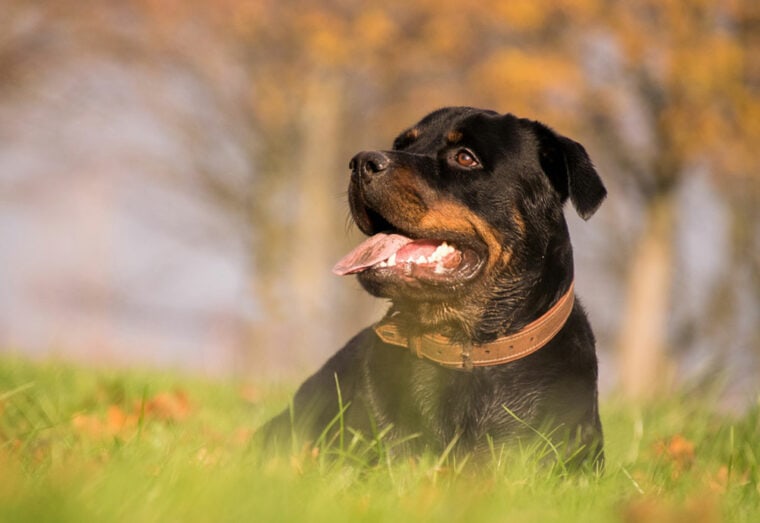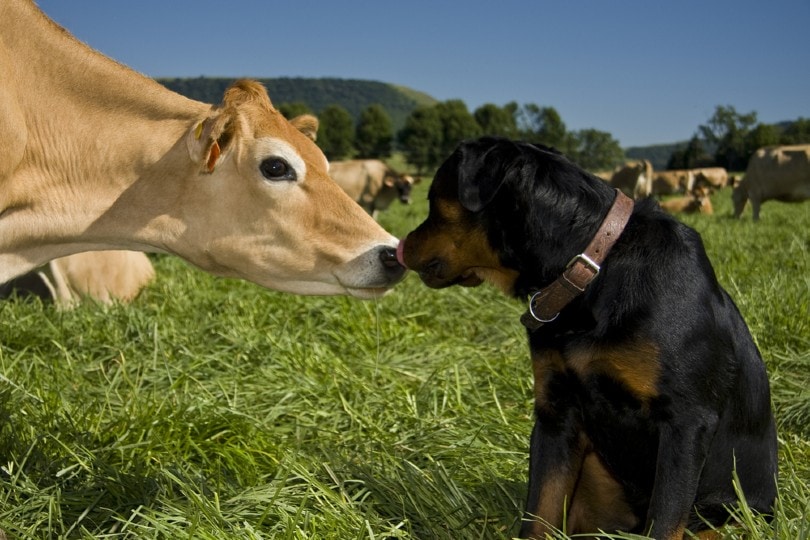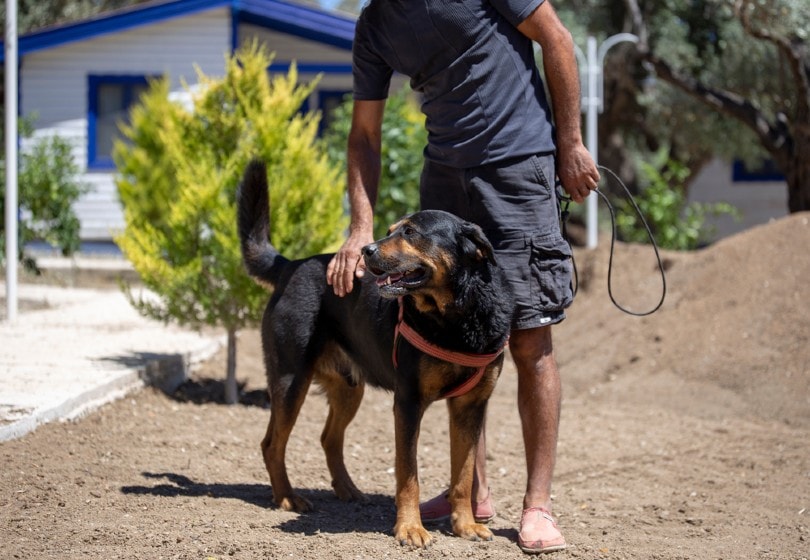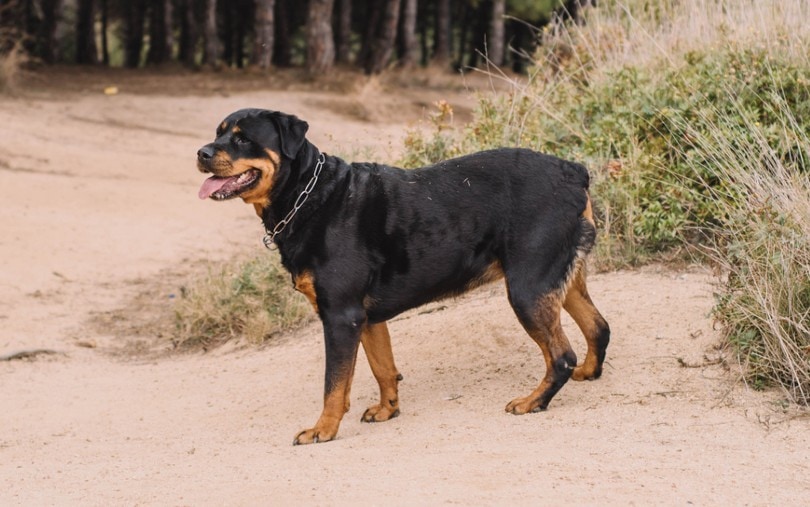
Rottweilers are medium-large dogs known for their loyalty and tenacity. They’re muscular, disciplined, and often work on search and rescue and law enforcement teams. Large males can reach up to 27 inches at the shoulders and weigh close to 135 pounds. Most have sleek black coats with mahogany, rust, or tan highlights. These loving dogs bond deeply with their humans and can be quite gentle with family members.
Rottweilers are relatively energetic, and activities like frisbee and flyball help keep them grounded. Good training is essential with these powerful dogs since it helps manage and properly channel their natural territorial and protective instincts. They were the 8th most popular breed in the US back in 2021, according to the American Kennel Club (AKC). Read on to learn 10 fascinating Rottweiler facts!

The 10 Fascinating Rottweiler Facts
1. Rottweilers Are An Extremely Old Working Breed
The ancestors of today’s Rottweilers were working dogs that spread throughout Europe alongside the Romans, who used them to guard and drive cattle. These dogs mixed with local dogs and got one step closer to modern Rottweilers. Over time, farmers began using these mixed-breed dogs to herd cattle and guard property.
During the 19th century, Rottweilers were most often used for herding, drafting, and guarding. The industrial revolution ushered in infrastructure and social changes that put herding and drafting animals out of work. Interest in the breed increased again once their value as police dogs was recognized in the 1900s. Rottweilers soared in popularity after their working skills were rediscovered.

2. Rottweilers Are Named After the City of Rottweil
Butchers in the city of Rottweil began relying on these dogs to guard their money and pull carts. Rottweil is an ancient city located in the southwest of modern Germany. It’s situated between the Swabian Alps and the Black Forest.
These powerful, protective dogs were once so closely associated with the city that they were called “Rottweil Butcher’s dogs.” But Rottweilers were officially described as a breed in 1901 when the International Club for Leonbergers and Rottweiler Dogs created the first breed standard.1 The AKC recognized Rottweilers in 1931.
3. Rottweilers Are Really Good Workers
The AKC classifies Rottweilers as a working breed, and these powerful dogs are happiest when doing a job. Historically, they’ve been used to herd, drive, and guard. Rottweilers have long been popular as police and military dogs and commonly work on search and rescue teams.
While Rottweilers have historically been associated with tough jobs like guarding money and property, these sensitive animals are also effective therapy dogs. Because they’re so attuned to their owners, many Rottweilers do well as service animals. A Rottweiler won the Award for Canine Excellence in Therapy in 2015.2

4. Rottweilers Have Powerful Bites
Rottweilers were bred to guard and protect, so it should be no surprise that these dogs have powerful bites. An adult Rottweiler’s bite force can reach up to 328 pounds per square inch (PSI). It’s far greater than what humans can produce (162 PSI on average) but far less than what a Nile crocodile can unleash.
Good training is essential for these dogs, as they’re incredibly muscular, have powerful bites, and tend to be protective. Rottweilers, like all dogs, respond best to reward-based training built around positive reinforcement, but even well-trained dogs shouldn’t be left alone with children.
5. Not All Rottweilers Have Docked Tails
Many Rottweilers in the US have docked tails. But Rottweilers in Australia, New Zealand, and many European nations usually don’t since tail docking is prohibited or restricted in these jurisdictions. The 2006 UK Animal Welfare Act prohibits the practice, except under extremely limited circumstances.
Tail docking has been around for millennia. The Romans clipped dogs’ tail tips since they believed the procedure protected animals against rabies transmission. Many working breeds, including Rottweilers, have historically had their tails docked to prevent tail injuries when pulling cars or darting under angry livestock.

6. Rottweilers Are Popular in Hollywood
Rottweilers have appeared in a few movies over the years, including The Omen and Lethal Weapon 3. One regularly appeared on Entourage, the 2000s HBO series about a fictional celebrity and his friends. Arnold, a Rottweiler, makes an appearance in the series’ very first episode.
Rottweilers are also popular celebrity pets! Will Smith, Bruno Mars, Leonardo DiCaprio, Sylvester Stallone, and Robbie Williams have all owned Rottweilers. Miley Cyrus even adopted a rescued Rottweiler-beagle mix in 2012.
7. Rottweilers Aren’t Frequent Barkers, and They’re Easy to Train
Rottweilers are relatively quiet; most simply aren’t inclined to get started on uncontrollable barking rolls. And while they’re incredibly athletic and enjoy physical activity, the breed isn’t prone to hyperactivity. Well-trained Rottweilers can be alert and relaxed at the same time, making them wonderful companions and guardians.
These intelligent dogs are also easy to train. Because of their working dog heritage, Rottweilers need serious mental stimulation and often thrive when learning or using skills to reach goals. Puppies can begin working on basic commands such as sit, stay, and no when they’re around 8 weeks old.

8. Rottweilers Are Late Bloomers and Serious Cuddlers
Rottweilers take a few years to reach full size. Some don’t fill out until they reach 2 or 3 years old, but most reach full height when they’re around one. They love to cuddle, often attempting to sit on their owners’ laps. They’ll follow their favorite people from room to room, as most prefer having company to being left alone. They also tend to lean on people, a trait most likely related to the breed’s herding instincts.
9. Rottweilers Don’t Live Very Long
While Rottweilers are incredibly strong, many live relatively short lives. The average Rottweiler lives 10–12 years., which is about average for large dogs. Giant breeds such as Great Danes and Irish Wolfhounds often only live 8–10 years. Small breeds, like Pomeranians and Rat Terriers, typically have relatively long lifespans, often making it 10–15 years.

10. Rottweilers Have the Same Markings
Rottweilers have beautified dark coats with tan, mahogany, or rust highlights, but those splashes of color always appear in the same places—on Rottweilers’ paws, muzzle, and chest! The AKC breed standard also calls for Rottweilers to have spots above their eyes. Rottweilers are double-coated dogs and typically have straight, dense outer coats and plush undercoats around their necks and upper legs. Most only require weekly brushings and occasional baths to stay looking sharp.

Summary
Rottweilers have quite a history; they’ve lived and worked alongside humans for thousands of years. They’re smart, loyal, and incredibly dedicated to their favorite humans. Good, early reward-based training is essential, as these muscular dogs can be a bit protective. They often focus intensely on one person, making them fantastic therapy dogs! While they were originally used for herding and guarding, Rottweilers now regularly work on search and rescue and law enforcement teams. Although these dogs often weigh as much as a grown human, they love to cuddle and sit on laps!
Featured Image Credit: Rebecca Scholz, Pixabay






